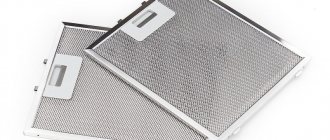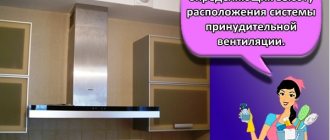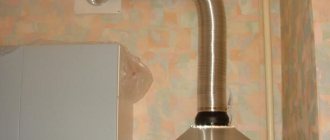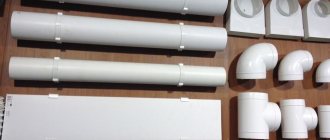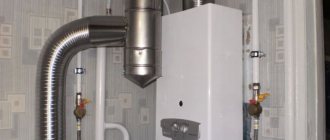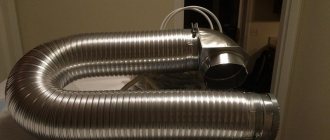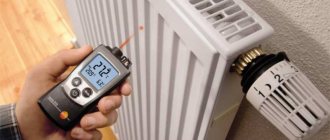A kitchen hood is a “headache” for every housewife who, due to her busy schedule, does not have the opportunity to wash this household appliance regularly. And it needs to be washed. And not only because a hood that collects grease splashing from the stove looks untidy, but rather because cooking under dirty household appliances is simply dangerous.
Cleaning a hood can hardly be a pleasant experience, but you can simplify this process and make your work easier if you choose the right cleaning products.
What is the best way to clean the hood and filter - 12 best home and store remedies
The dirtiest part of the hood, as you know, is the filter. It accounts for the lion's share of all fat, fumes, odors, etc.
How to choose the right hood for the kitchen, what to look for - types of hoods, pros and cons
The less often you clean the filters, the harder it is to wash them.
In addition, dirty filters impair the performance of the equipment itself and increase its energy consumption. Therefore, regular cleaning of filters saves both effort and money.
As for the body of the equipment itself, it is much easier to clean. Unless, of course, you do this more than once a year “on holidays.”
How often should you clean your hood?
Cleaning up a heavily soiled, dried-out filter requires a lot of work and a considerable amount of money. How to wash the hood in the kitchen, so as not to bring it to such a deplorable state, so as not to spend a huge amount of time and labor on removing stuck-on plaque - you need to follow several rules:
- Do not leave the stove burners on when food is not being cooked on them. The heat that emanates causes fat to burn onto the hood parts.
- Regularly care for surfaces. The outer dome, buttons, internal circuits, with free access, not covered by a panel, must be wiped after each cooking.
- Removable parts and filters should be cleaned once every 1-3 months, depending on the intensity of use.
Timely cleaning will preserve the appearance.
This will allow the hood to maintain its functionality for a long time. Cooking in a clean kitchen is much more enjoyable. Previous Hood How to wash stainless steel at home?
Home remedies (use whatever you have on hand):
- Vinegar. Traditional 9% vinegar cannot cope with a serious layer of fat and soot, so the ideal option is acetic acid (approx. 70%). It is used undiluted and with windows open (the product has a pungent odor). Naturally, all work should be carried out with special gloves (for this and all other means). Wet a sponge in vinegar and wipe the contaminated surfaces with it. We put the filters in a baking tray, fill them with the same vinegar and take them out after 7-12 minutes. We remove the remaining plaque using a special brush. All that remains is to rinse the filters under warm water and dry. To remove fresh grease stains, you can use regular table vinegar or dilute 70% acetic acid in half with water.
- Laundry soap 72%. The method is simple, safe, cheap. Grate the soap into a couple of handfuls of shavings. Next, dissolve the shavings in boiling water, stir, pour the solution onto a baking sheet and place the hood filter there for half an hour. If there is a suitable container to “boil” the filters, then do not remove the container from the heat - lower the filter into it and “cook” over low heat for 30 minutes. We remove the remaining fat with a brush, then wash the hood parts and dry them dry.
- Lemon acid. We use acid or lemon slices to treat the hood and filters. The method is good for regular cleaning of the hood - a thick layer of fat is not suitable for a lemon. We dilute the acid in a liter of warm water (3 tbsp/l) and fill the filter lowered into the container. After 15 minutes, clean with a brush. Severe fat deposits will require multiple treatments.
- Ammonia. A very effective remedy for both old and fresh fatty stains. Remember that ammonia is not a flavoring agent and requires careful use and open windows. Heat the water to 50 degrees, add ammonia (approx. ½ cup per 4 liters), lower the dirty parts into the container for 4 hours. Next, all that remains is to lightly go over it with a sponge, rinse and dry.
- Mustard. Another old kitchen helper from the series of “grandmother’s tips.” A safe method, but it is still recommended to open the windows. In cold water, the effectiveness of mustard is greatly reduced, so it is recommended to dissolve the powder in warm, almost hot water: for 4 tbsp mustard powder - 2 tsp fairy, 2 tbsp water and 2 tbsp vinegar. We spread the pulp on the parts and “wrap” the hood in it. After 30 minutes, wash off the remaining fat with a brush, rinse everything under warm water, and dry.
- Boiling. You can’t put the hood itself into the container, so the method is only good for parts - for example, for filters that most need powerful cleaning. Pour water into a container that allows you to lower the entire filter into it (for example, a rectangular baking tray), add “to taste” - soap shavings, powder, fairy or soda with salt. Or better yet, all at once. Next, lower the filters and simmer them over low heat until the water turns yellow-brown. If the grate is still dirty, drain the water and repeat the procedure. If you don’t have the necessary containers, you can boil the filters in half – by dropping them, for example, into a saucepan.
Types of devices
If you are just planning to purchase a modern and reliable hood for your kitchen, then you should find out in more detail what types of hoods are available and how they differ from each other.
Let's start with the fact that they differ in their design, design, and functionality. The most common option is dome hoods. Many have already become accustomed to this design, and modern manufacturers are increasingly surprising consumers with the original design of these hoods.
As a rule, dome-type appliances are equipped with two types of filters: an aluminum grease filter and a carbon filter. The first type of filter performs the function of a so-called grease trap, that is, it traps particles of fat and soot and periodically requires thorough cleaning.
Another common type of this kitchen appliance is hanging hoods. Many people are attracted by their compact size and ease of installation. This device can be easily installed under a kitchen cabinet, which is very practical as it can save space. As a rule, such hoods are equipped with carbon filters.
Island hoods are an excellent option for those kitchens where there is an “island” on which all appliances are installed: stove, oven, etc. This type of hood cannot be mounted on a wall or under a cabinet; they are suspended directly from the ceiling so that the appliance is directly above the stove itself.
There are also built-in options that are equipped with a retractable panel
In addition, it is important to know that hoods can operate in two modes. The first is the “retract” mode
That is, during operation of the device, all polluted air from the kitchen is removed through ventilation, thereby cleaning the room. The second is “recycling”. During operation of this mode, the hood sucks in polluted air from the kitchen, cleans it using installed filters, in particular carbon filters, and then delivers it back to the kitchen.
As soon as you become the happy owner of this device, your kitchen will always be clean and cozy. There will be no more burning smell or grease stains on your kitchen furniture.
Store-bought products that quickly dissolve fat:
- Grease remover spray Sanita. It acts quickly, contains active components: it instantly “corrodes” even old fatty deposits and other dirt. The most popular is the express spray, which can be used to wash both the tiles above the stove and the stove itself. Easily copes even with black deposits on baking sheets and stove grates. Cost about 200 rubles.
- Cinderella Anti-fat spray. Soda “water” in a spray bottle, as soon as it appeared, quickly took up residence in the apartments of the housewives. Because it is effective, inexpensive (about 80 rubles) and effortless. The product is based on natural soda and, although it does not act as quickly as heavy chemical artillery, it works at 5 plus, easily washing off grease from the hood, stove, and other surfaces.
- Cif Anti-Grease Spray. Sif is known for its effectiveness and gentleness. Instantly dissolving fat, it does not leave scratches on surfaces, destroys unpleasant odors, and after using this product, the renewed surfaces remain perfectly clean, fresh and shiny. The price for pleasure is about 200 rubles.
- Gel spray Safe and super-effective Synergetic based on soda is also a very popular product. This spray can easily cope with hoods, microwaves, stoves, tiles, etc. Price – about 300 rubles. (a little expensive, but we pay extra for the safety of the product for health and the absence of powerful chemicals in the composition).
- Anti-fat Radiance gel Cilit Bang . Cost – about 230 rubles. This Polish “nugget” from the household chemicals segment is produced on the basis of soft surfactants and without abrasives. It copes with grease, light carbon deposits and dirt perfectly well, but is practically powerless against old rust.
- Gel/spray Shumanit Bugs. Powerful, almost “vigorous” Schumanit washes everything that can be washed. And sometimes even what didn’t need to be washed. Therefore, it is not recommended to use this Israeli product on surfaces not intended for this purpose. The price of the product is about 300 rubles, but it is quite justified, considering that Shumanit easily copes with even the oldest carbon deposits - until it shines and squeaks! In addition, it does not have abrasives, destroys bacteria, is economical and acts simply instantly after application. Stock up on gloves and a respirator - the product does not smell of lavender.
How to clean frying pans from grease and carbon deposits?
Preparing the hood for cleaning and washing - what is important?
Considering that a range hood is not a pan, but a household appliance that cannot simply be put in the sink and washed, first of all we study the instructions.
- We disconnect the equipment from the network.
- We disassemble what, according to the instructions, can be disassembled.
- We remove the protective surface of the equipment.
- We take out the filter.
- We soak all removable parts.
- At the same time, we unscrew the pipe that removes dirty air through the hood and further into the ventilation. It also needs cleaning!
- We check the hood body for contamination.
Recommendations
Of course, each family has its own rules and peculiarities for cleaning the house. Cleaning can be done daily, or maybe once a week. As for the kitchen hood, it does not require daily cleaning, even though it is used every day. But you shouldn’t neglect this moment, so as not to complicate your task.
It is also known that modern models use replaceable filters, which only need to be changed once every three months, which will save a lot of time and energy. But owners of more outdated models should arm themselves with detergent and clean them at least once a month.
In addition to the internal parts of the hood, do not forget about the outer hood. After all, it is also contaminated not only with fat, but also covered with dust. If you start this process, then it will be very difficult to wash the outer part of the device. To avoid this situation, you should treat the surface of the hood with some kind of grease remover. Individual greasy spots can be removed using a metal scraper.
Armed with all the above recommendations, you can safely begin general cleaning of the kitchen hood, choosing the most suitable method for you.
Therefore, the recommended washing scheme is as follows:
- After you have disconnected the equipment from the network, pulled out the filter and other removable parts, we wash the housing itself. First, moisten it with warm water using a sponge.
- Next, apply a soft but strong product to the surface of the hood. For example, Sif.
- If the hood is domed and the dome is removable, the inside should also be washed. That is, we apply the product from the inside too.
- After 15 minutes, use the hard side of a regular sponge to wash the surfaces, not forgetting the panel with buttons and side parts.
- Use a rag to remove any remaining product.
- Wipe dry on all sides.
How and with what to clean the kitchen hood filter from grease and dirt?
If none of the methods described above suits you, then here are a few more options for cleaning your hood and filters from grease:
- First of all, I would like to note the benefits of a dishwasher in this matter. It is most convenient to wash easily dirty filters in it. It cannot handle strong grease and carbon deposits, but it is suitable for regular washing of parts.
- Heavy chemical artillery. If even Schumanit does not remove the filters from your hood (which is unlikely, it is usually sufficient), use a product (one of which you can choose from - there are many of them in stores) to clean water pipes. For example, Mole, Selena and Sanfor, Chirton and Sanox, Pothan, Tiret and others. The downside is that the filter grilles may darken. In addition, the products are very “toxic” - work with gloves, a respirator and with open windows.
- Steam cleaning. If you still don’t have a steam generator, you’re missing out. With its help you can solve many everyday problems. This unit makes it easy to clean any surface, and in most cases does not require the additional use of chemicals. In addition, the device also ensures disinfection of surfaces, and grease, under the influence of temperatures of more than 150 degrees, comes off the filters without any effort in minutes.
